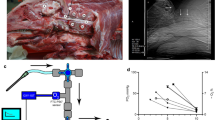Abstract
We used high performance liquid chromatography to determine the concentration of purine metabolites in the cerebrospinal fluid of three hydrocephalic children with a history of shunt malfunction. Hypoxanthine and xanthine levels were high in comparison with controls. We consider these purines to be valuable indicators of disturbance of neuronal metabolism following the sustained rise in intracranial pressure caused by shunt valve malfunction.
Similar content being viewed by others
References
Barlow CF (1984) CSF dynamics in hydrocephalus — with special attention to external hydrocephalus. Brain Dev 6:119–127
Bejar R, Saugstad OD, James H, Gluck L (1983) Increased hypoxanthine concentrations in cerebrospinal fluid of infants with hydrocephalus. J Pediatr 103:44–48
Castro-Gago M, Tato F, Martinez Rumbo R, Pavón P, Fraga JM (1980) Hidrocefalias no tumorales de la infancia. Importancia del estudio de la dinámica del líquido cefalorraquideo para el diagnóstico y actitud terapéutica. Rev Esp Pediatr 36:61–74
Castro-Gago M, Lojo S, Del Río R, Rodríguez A, Novo I, Rodríguez-Segade S (1986) The concentrations of xanthine and hypoxanthine in cerebrospinal fluid as therapeutic guides in hydrocephalus. Child's Nerv Syst 2:109–111
Castro-Gago M, Novo I, Ugarte J, Pombo M, Tojo R, Peña J (1986) Criterios de autocompensación en las hidrocefalias infantiles. Rev Esp Pediatr 42:237–242
Castro-Gago M, Novo I, Rodríguez-Núñez A, Peña J, Lojo S, Rodríguez-Segade S (1989) Therapeutic criteria in hydrocephalic children. Child's Nerv Syst 5:361–363
Castro-Gago M, Camiña F, Lojo S, Rodríguez-Segade S, Rodríguez-Núñez A (1992) Concentrations of purine nucleotides and purine and pyrimidine bases in cerebrospinal fluid of neurologically healthy children. Eur J Clin Chem Clin Biochem 30:761–765
Costa J (1988) Hidrocefalia en el niño. In: Fejerman N, Fernández-Alvarez E (eds) Neurologia pediátrica. El Ateneo, Buenos Aires, pp 7.52–7.61
De Vries LS, Smet M, Ceulemans B (1990) The role of high resolution ultrasound and MRI in the investigations of infants with macrocephaly. Neuropediatrics 21:72–75
Fandiño Rivera J, Botana López C, Viladrich Carreira A (1990) Derivación ventrículo peritoneal en el tratamiento de la hidrocefalia infantil. Resultados y complicaciones. An Esp Pediatr 32:325–328
Gaab MR, Koos WT (1984) Hydrocephalus in infancy and childhood: diagnosis and indication for operation. Neuropediatrics 15:173–179
Hack CH, Enrile BG, Donat JF, Kosnik E (1990) Seizures in relation to shunt dysfunction in children with meningomyelocele. J Pediatr 116:57–60
Harkness RA, Lund RJ (1983) Cerebrospinal fluid concentrations of hypoxanthine, xanthine, uridine and inosine: high concentrations of the ATP metabolite, hypoxanthine after hypoxia. J Clin Pathol 36:1–8
Hayden PW, Shurtleff DB, Stuntz TJ (1983) A longitudinal study of shunt function in 360 patients with hydrocephalus. Dev Med Child Neurol 25:334–337
Kaiser AM, Whitelaw AGL (1987) Non-invasive monitoring of intracranial pressure — fact of fancy? Dev Med Child Neurol 29:320–326
Levin SD, Brown JK, Harkness RA (1984) Cerebrospinal fluid hypoxanthine and xanthine concentrations as indicators of metabolic damage due to raised intracranial pressure in hydrocephalic children. J Neurol Neurosurg Psychiatry 47:730–733
Liptak GS, McDonald JV (1986) Ventriculoperitoneal shunts in children: factors affecting shunt survival. Pediatr Neurosci 12:289–293
Lorber J, Priestley BL (1981) Children with large heads: a practical approach to diagnosis in 557 children, with special reference to 109 children with megalencephaly. Dev Med Child Neurol 23:494–504
Raimondi AJ (1988) Shunts, indications, problems, and characteristics. Child's Nerv Syst 4:321–324
Rul-Lan Losada G, Costa Clara JM, Lafuente Millán J, Fernández Alvarez E (1985) Sindrome de ventrículos colapsados (“slit-ventricle”). A propósito de ocho observaciones. An Esp Pediatr 22:129–136
Saugstad OD (1988) Hypoxanthine as an indicator of hypoxia: its role in health and disease through free radical production. Pediatr Res 23:143–150
Saugstad OD, Schrader H, Aasen AO (1976) Alteration of the hypoxanthine level in cerebrospinal fluid as an indicator of tissue hypoxia. Brain Res 112:188–191
Shurtleff DB, Stuntz JT, Hayden PW (1986) Experience with 1201 cerebrospinal fluid shunt procedures. Pediatr Neurosci 12:49–57
Simmonds RJ, Harkness RA (1981) High performance liquid chromatographic methods for base and nucleoside analysis in extracellular fluids and in cells. J Chromatogr 226:369–381
Volpe JJ, Pasternak JF, Allan WC (1977) Ventricular dilation preceding rapid head growth following neonatal intracranial hemorrhage. Am J Dis Child 131:1212–1215
Zakaria M, Brown PR (1981) High-performance liquid column chromatography of nucleotides, nucleosides and bases. J Chromatogr 226:267–290
Zamora I, Lurbe A, Alvarez-Garijo A, Mendizabal S, Simon J (1984) Shunt nephritis: a report on five children. Child's Brain 11:183–187
Author information
Authors and Affiliations
Rights and permissions
About this article
Cite this article
Castro-Gago, M., Rodríguez-Segade, S., Camiña, F. et al. Indicators of hypoxia in cerebrospinal fluid of hydrocephalic children with suspected shunt malfunction. Child's Nerv Syst 9, 275–277 (1993). https://doi.org/10.1007/BF00306272
Received:
Issue Date:
DOI: https://doi.org/10.1007/BF00306272




